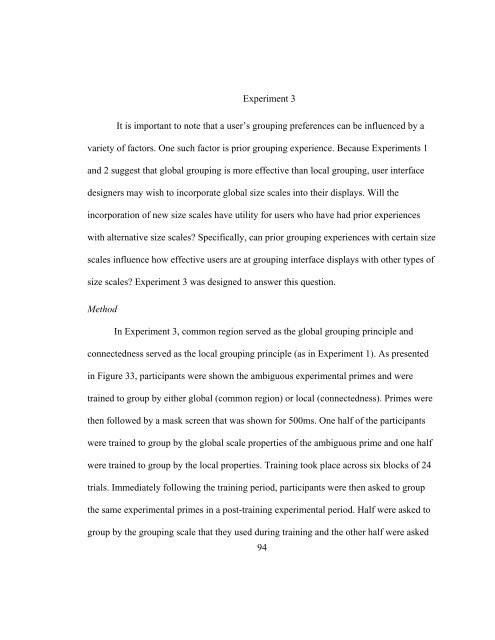The Use of Iambic Pentameter in the
The Use of Iambic Pentameter in the
The Use of Iambic Pentameter in the
Create successful ePaper yourself
Turn your PDF publications into a flip-book with our unique Google optimized e-Paper software.
Experiment 3<br />
It is important to note that a user’s group<strong>in</strong>g preferences can be <strong>in</strong>fluenced by a<br />
variety <strong>of</strong> factors. One such factor is prior group<strong>in</strong>g experience. Because Experiments 1<br />
and 2 suggest that global group<strong>in</strong>g is more effective than local group<strong>in</strong>g, user <strong>in</strong>terface<br />
designers may wish to <strong>in</strong>corporate global size scales <strong>in</strong>to <strong>the</strong>ir displays. Will <strong>the</strong><br />
<strong>in</strong>corporation <strong>of</strong> new size scales have utility for users who have had prior experiences<br />
with alternative size scales? Specifically, can prior group<strong>in</strong>g experiences with certa<strong>in</strong> size<br />
scales <strong>in</strong>fluence how effective users are at group<strong>in</strong>g <strong>in</strong>terface displays with o<strong>the</strong>r types <strong>of</strong><br />
size scales? Experiment 3 was designed to answer this question.<br />
Method<br />
In Experiment 3, common region served as <strong>the</strong> global group<strong>in</strong>g pr<strong>in</strong>ciple and<br />
connectedness served as <strong>the</strong> local group<strong>in</strong>g pr<strong>in</strong>ciple (as <strong>in</strong> Experiment 1). As presented<br />
<strong>in</strong> Figure 33, participants were shown <strong>the</strong> ambiguous experimental primes and were<br />
tra<strong>in</strong>ed to group by ei<strong>the</strong>r global (common region) or local (connectedness). Primes were<br />
<strong>the</strong>n followed by a mask screen that was shown for 500ms. One half <strong>of</strong> <strong>the</strong> participants<br />
were tra<strong>in</strong>ed to group by <strong>the</strong> global scale properties <strong>of</strong> <strong>the</strong> ambiguous prime and one half<br />
were tra<strong>in</strong>ed to group by <strong>the</strong> local properties. Tra<strong>in</strong><strong>in</strong>g took place across six blocks <strong>of</strong> 24<br />
trials. Immediately follow<strong>in</strong>g <strong>the</strong> tra<strong>in</strong><strong>in</strong>g period, participants were <strong>the</strong>n asked to group<br />
<strong>the</strong> same experimental primes <strong>in</strong> a post-tra<strong>in</strong><strong>in</strong>g experimental period. Half were asked to<br />
group by <strong>the</strong> group<strong>in</strong>g scale that <strong>the</strong>y used dur<strong>in</strong>g tra<strong>in</strong><strong>in</strong>g and <strong>the</strong> o<strong>the</strong>r half were asked<br />
94

















